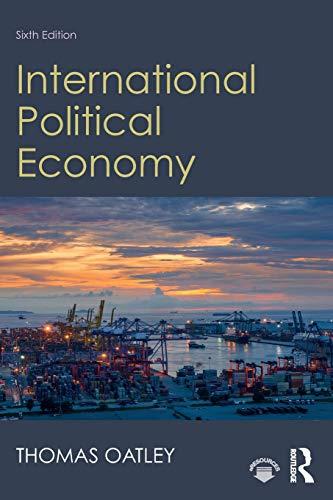Question
QUESTION 9 Bonus. Country B is twice as far from country A than country C, but country B's GDP is twice as large as country
QUESTION 9
Bonus. Country B is twice as far from country A than country C, but country B's GDP is twice as large as country C. According to the gravity model, which country will trade most with country A?
| a. | Country B | |
| b. | Country C | |
| c. | Both countries will trade the same amount with country A |
QUESTION 10
Free trade in the monopolistic competition and increasing returns to scale model will
| a. | shift the average cost curve downwards | |
| b. | shift the average cost curve upwards | |
| c. | flatten the demand curve facing the firm | |
| d. | steepen the demand curve facing the firm |
QUESTION 11
The consumption distortion of a tariff is calculated as
| a. | Demand before the tariff minus demand after the tariff | |
| b. | One-half times (demand before the tariff minus demand after the tariff) | |
| c. | Supply before the tariff minus supply after the tariff | |
| d. | One-half times (supply before the tariff minus supply after the tariff) |
QUESTION 12
If the home country is labor abundant, free trade in the Heckscher-Ohlin model will shift
| a. | the relative demand curve (RD) for labor rightwards and raise the wage-rental ratio | |
| b. | the relative demand curve for labor rightwards and lower the wage-rental ratio | |
| c. | the relative demand curve for labor leftwards and raise the wage-rental ratio | |
| d. | the relative demand curve for labor leftwards and lower the wage-rental ratio |
QUESTION 13
Assume the specific factors model where capital and labor are used to make autos and land and labor are used to make wheat. An increase in the relative price of autos due to trade will cause firms
| a. | to produce only autos | |
| b. | produce more autos and less wheat | |
| c. | produce more of both goods, but increase auto production more than wheat production | |
| d. | produce more wheat and fewer autos |
QUESTION 14
Assume the specific factors model where capital and labor are used to produce autos and land and labor are used to produce wheat. If free trade increases the relative price of autos in the home country, what effect will this have on capital income?
| a. | Increase capital income in both the home country and the foreign country | |
| b. | Decrease capital income in both the home country and the foreign country | |
| c. | Increase capital income in the home country and decrease capital income in the foreign country | |
| d. | Decrease capital income in the home country and increase capital income in the foreign country |
QUESTION 15
Assume the Heckscher-Ohlin model where the home country is capital abundant, autos are capital intensive and clothing is labor intensive. Before trade,
| a. | Wages in the auto industry will be higher than wages in the clothing industry | |
| b. | Wages in the clothing industry will be higher than wages in the auto industry | |
| c. | Wages will be the same in both industries |
QUESTION 16
Some analysts argue that the U.S. should not trade with developing countries because trade will drive U.S. wages down to develooping country levels. The model that is most supportive of this view is
| a. | Ricardian | |
| b. | Specific-factors | |
| c. | Heckscher-Ohlin | |
| d. | Monopolistic competition and increasing returns to scale |
Step by Step Solution
There are 3 Steps involved in it
Step: 1

Get Instant Access to Expert-Tailored Solutions
See step-by-step solutions with expert insights and AI powered tools for academic success
Step: 2

Step: 3

Ace Your Homework with AI
Get the answers you need in no time with our AI-driven, step-by-step assistance
Get Started


